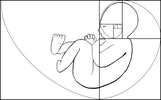Primitive Reflexes Cheat Sheet
![]()
Reflex Name | Description | Age Develops | Age Inhibited | Signs and Symptoms of Retention |
Moro Reflex |
| Begins to develop 9 weeks in utero | 2‐4 months of life |
|
Palmar Reflex |
| Begins to develop 11 weeks in utero | 2‐3 months of life | |
Asymmetrical Tonic Neck Reflex (ATNR) |
| Begins to develop 18 weeks in utero | Approx. 6 months of life |
|
Roo ng Reflex (Grasp Reflex) |
| Begins to develop 24‐28 weeks in utero | 3‐4 months of life |
|
Spinal Galant Reflex |
| Begins to develop 20 weeks in utero | 3‐9 months of life |
|
Reflex Name | Description | Age Develops | Age Inhibited | Signs and Symptoms of Retention |
Tonic Labyrinthine Reflex (TLR) |
| Flexion: Begins to develop in utero Extension: Present at birth | Flexion: Approx. 4 months of life Extension: Up to 3 years old |
|
Symmetrical Tonic Neck Reflex (STNR)* |
| Both flexion and extension emerges 6‐9 months of life | Both flexion and extension 9‐11 months of life |
|
Landau Reflex* |
| Emerges 4‐5 months of life | 3.5 years of life |
|
![]()
*Considered a “bridge” reflex between primitive and postural References:
